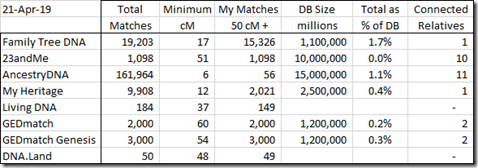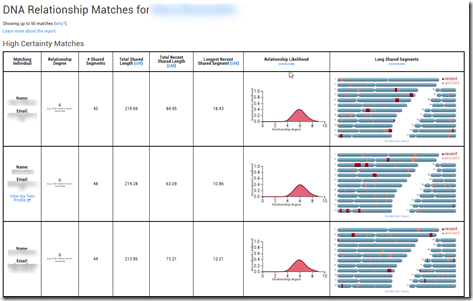I saw a post on Facebook trying to compare the number of relative matches a person hade at different DNA testing companies.
Here’s my results with my endogamy:
Note that there are a few things to consider when you or anyone else does a comparison of your number of DNA matches.
A few companies only give you a specific number of matches. GEDmatch gives 2,000, GEDmatch Genesis gives 3,000, and 23andMe limit you to 2,000 but only lets you see those that have opted in to sharing.
Some companies give you all your matches down to some minimum threshold. The minimum cM is not necessarily the only criteria. Largest segment length and number of segments may be considered. Ultimately, that works out to an effective minimum Total cM for me at Living DNA of 37 cM, at Family Tree DNA of 17 cM, at MyHeritage of 12 cM and at AncestryDNA of 6 cM. Since Ancestry DNA goes right down to matches who have a single segment matching of just 6 cM, I expectedly have a very large total number of matches with them. Even without endogamy, you will likely have your largest number of matches at AncestryDNA as well because of this low matching limit.
If you look at only larger matches, you get a completely different story. I counted the number of matches I had that were a total of 50 cM or more. You’ll see I have very few, just 56 matches at Ancestry DNA. That’s because Ancestry uses their Timber algorithm to eliminate many segments they consider to be false. Whereas Family Tree DNA have a lot of matches 50 cM or more simply because they include segments right down to 1 cM in their total, and therefore will have a larger Total cM than the same match at another company
I’ve added a Database size column. These are numbers I have visually read off of Leah Larkin’s www.theDNAgeek.com/dna-tests chart of Autosomal DNA Database Growth as of April 2019.
When you divide the matches by the database size, in my case, my largest proportion of the database I match to is 1.7% at Family Tree DNA, and then 1.1% at AncestryDNA.
All those statistics are just statistics. What’s much more important and what we as genealogists want, are people who we can determine our exact connection to and can determine a Most Recent Common Ancestor for. These are the people who through DNA and genealogy, will help us to expand our family tree.
My endogamy does give me lots of matches, but I have few connections I can determine because Romanian and Ukrainian records rarely go back further than the mid 1800’s limiting me to about 5 generations genealogically. My best success so far in finding DNA testers whose relationship (well at least one, there may be others) I’ve been able to determine are 11 relatives at AncestryDNA and 10 at 23andMe. At Ancestry, that’s 11 out of the 56 people sharing 50 cM or more.
Ah the thrill of another cousin testing! Two days ago, a 1st cousin on my Mom’s side showed up at AncestryDNA. And just this morning, a 1C1R on my Dad’s side showed up at 23andMe. Go Testers Go!!
If you’ve already tested everywhere, GEDmatch and DNA.Land won’t help you on this front, because they only accept uploads from other companies. So you’ll already match with them at the company they originally tested at. But these upload sites will help you with the additional tools they provide.
My upload to DNA Land does not show any matches for me. I think that’s strange considering that they show 50 matches (their limit) for my uncle’s upload (which I’ve included in the above chart). The 50 matches go down to 48 cM (of what they call Total Recent Shared Length). If you haven’t seen their match report, it is interesting and looks like this:
In conclusion, each company uses different algorithms to determine what they consider a match. So it is not really possible to fairly compare matches between companies.
The main thing you want to find from your matches are identifiable relatives. So the best bet is still to fish in as many ponds as you can.


